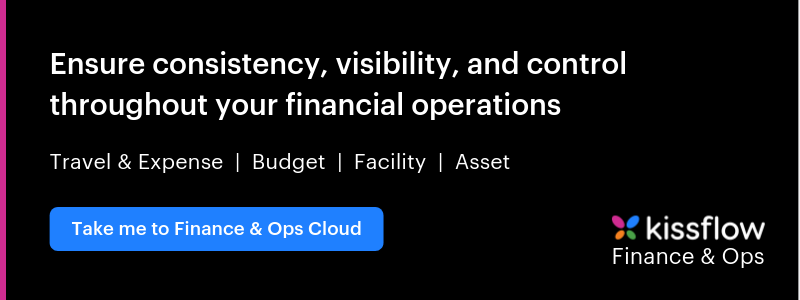Can Workflow Automation Kick Out the Chaos of Your Budget Approval Process?
Creating an effective budget approval is a daunting task. Whether you’re running a small business or a department in an enterprise, forecasting your expenses for the coming months is crucial. Budgets rely on expected sales, market conditions, seasonal ups and downs, and take a lot of planning. Without accurate budgets, each department won’t know how to reach their goals and targets.
But when you add in an old rusty approval process to an already precarious budget creation, it can turn the whole thing into a sideshow. Unvalidated data and approvals that can drag on for weeks mean that, sometimes, you end up operating without an up-to-date budget which drags the whole organization into turmoil.
What is budget workflow?
A budget workflow starts with an estimation of revenue over a specified future period of time. Every department in the organization sets its budget. These are then approved by the finance team. The budget workflow ensures that every department has adequate funds allocated to them for effective functioning.
Advantages of automating your budget approval process:
1. More Transparency
A well-defined workflow ensures that everyone involved the budget process knows what the next step is. Reviews and corrections are all documented and everyone stays informed.
2. Improved Accuracy
When you get data directly from your accounting, payroll, and expense tools to your budgeting software, you can rest assured that there are no manual errors.
3. Uniform Budgets
Using a workflow automation tool ensures that all the budgets from different department heads have the same readable format, no matter who prepares them.
4. Faster Approvals
When employees have a clear idea of the organization’s policies, they make more accurate and compliant budgets. There’s less bouncing back and forth, and approvals get faster.
5. Flexible Budgets
Quite often than not, budgets are constantly changing according to business conditions. You can’t rely on manual processes for a quick re-iteration or what-if scenarios. Automation makes the process more nimble while still keeping the required controls over the workflow and data.
As your business grows and branches into multiple departments, budgeting becomes more complex and harder; it becomes difficult to have the desired level of details in your budget.

A Peek Inside the Budget Approval Process
Esteban runs a SaaS company with 30 employees. They don’t have an official finance team in place, but, as in most startups, they find a way. He recently found out that Christina, who is an engineering lead, has a background in finance, so he asked her to consolidate and review the budget approvals.
Each department made its own budget, and then Esteban approved them based on the sales projections, after Christina’s initial evaluation. They used spreadsheets to prepare the budget, and emails for communication.
While the entire budget management process sounds straightforward, it was far from simple in practice.
Steps involved in a budget approval process:
1. Setting Budget Policies
During the first week of October, Christina and Esteban started thinking about plans and strategy for the upcoming fiscal year. A series of emails later, they agreed upon a set of guidelines for expenditure limits and organizational goals. Christina made sure that the goals were attainable and realistic.
2. Preparing the Budget
Christina then emailed all the department heads, asking them to prepare the budget approval process for their departments. The department heads prepared the budgets, taking into account data from previous years and sharing their projections of expenses and revenue for the next quarter.
It took them more time than it should have, because they relied heavily on manual processes. They had to switch back and forth between spreadsheets and their accounting software, and key in all the data manually. Only one department head sent the budget on time, and Christina was left chasing after everyone else with multiple email reminders asking them to send her their budgets.
3. Consolidating the Budget
Once the departmental budgets were prepared, Christina reviewed each of them and made sure that they adhered to the organizational guidelines. If some of the budgets were non-compliant, and she had to send them back via email with comments on the spreadsheet.
One of the department heads accidentally sent Christina an older version of the budget and that resulted in a lot of confusion. It turned out there were so many documents with similar names and it took them a good while to find the final version.
The department numbers were often error-prone. There was no data validation and she had to verify each piece of information to ensure Esteban had the right numbers while making important decisions.
Once all departmental budgets were error-free, Christina consolidated them to create the master budget for the whole organization. She categorized the expenses into capital expenditures, operating expenditures (rent, Internet, payroll, marketing), non-cash expenditures like depreciation, and taxes. She analyzed the proposed expenses and the assumptions made by the revenue-producing departments.
4. Review by the Leadership Team
After reviewing the budget, Esteban brought together all the department heads to have a collaborative discussion about the budget approval system. They were asked to share their goals for the fiscal year and what resources they needed to achieve them.
They were also given a chance to justify the requested expenses. Esteban made sure that every department has adequate funding for smooth functioning, and discussed the consequence of the budget cuts, making a conscious decision once they were on the same page.
Due to significant delays, the whole process spilled over into January the following year. Even though she got the work done, Christina vowed to never get involved again as her engineering work suffered greatly, and the department heads had started ignoring her email pleas for revisions.
What went wrong with their budget approval process?
One of the reasons why the budget approval process often drags on is that there is no process in place. The data doesn’t move anywhere on its own, and dozens of emails need to be exchanged to pass on information and ask for approval.
The budget approval process becomes even harder with multiple versions of the budget floating around. By the end, many companies are not confident of the final data, and some sensitive information like salaries from other departments may prove hard to keep confidential.
Inboxes become flooded with change requests. Miscommunication is routine, and leaders aren’t sure if they actually approved the correct version. It’s easy to blame someone else, and no one is ultimately held responsible.
Here’s a better way
If Esteban had used a budget workflow automation tool like Kissflow Finance and Operations Cloud, it would have helped them define a process that every person in the organization could follow easily. It would have helped them cut down on the budget preparation time. There would be options to integrate all their tools in order to minimize data entry. This would have led to fewer errors and Christina would have been confident about the integrity of her data.

